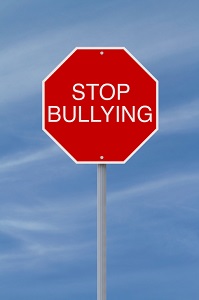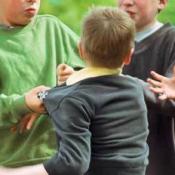 If you’ve ever seen A Christmas Story, then you probably remember the words of the yellow-eyed, redheaded Scut Farkus as he taunts and tortures 9-year-old Ralphie Parker: “Come on, cry baby, cry!” As Farkus jeers with a maniacal laugh and violence flashing in his eyes, Ralphie finally snaps and fights back, pummeling his bully into the snowy earth.
If you’ve ever seen A Christmas Story, then you probably remember the words of the yellow-eyed, redheaded Scut Farkus as he taunts and tortures 9-year-old Ralphie Parker: “Come on, cry baby, cry!” As Farkus jeers with a maniacal laugh and violence flashing in his eyes, Ralphie finally snaps and fights back, pummeling his bully into the snowy earth.
While it is understandable to feel a sense of satisfaction watching someone overtake a bully and feel vindicated in a classic film scenario, this scene in A Christmas Story, as Ralphie’s mother insists, is not the ideal for those fighting to raise awareness and effect societal change where bullying is concerned.
Bullying of both a physical and psychological nature are realities many youth face on a day-to-day basis. StopBullying.gov states that for a behavior to be considered bullying, it “must be aggressive” and include “an imbalance of power” and “repetition” or the potential to become repetitive. Bullying may manifest as physical violence and abuse against those perceived as weak or different; it may also appear in the form of words and phrases used to hurt those same individuals. It happens in schools, homes, and the community at large, and is primarily associated with youth who are 18 and younger.
National Bullying Prevention Month, which was initiated in 2006 by PACER’s National Center for Bullying Prevention, encourages supporters and advocates to stand up and say, “The end of bullying begins with me.” Whether as a perpetrator, as a bystander, or as someone who has experienced bullying, everyone can play a part in putting a stop to the damaging effects of bullying.
Unity and Respect: Valuable Bullying Prevention Lessons
A variety of campaigns and opportunities to stand united with the movement to prevent bullying are accessible online. StopBullying.gov provides the public with resources and educational materials pertaining to bullying, and at StompOutBullying.org, those who wish to show their support can purchase wristbands, as well as access information on what’s been happening when and where regarding bullying prevention awareness.
The Parent Advocacy Coalition for Educational Rights website (PACER.org) is also an excellent resource. In addition to informational links and materials, the site encourages concerned citizens to sign their “The End of Bullying Begins with Me” petition. And perhaps most useful with regard to practical, long-term application and prevention is PACER’s free, online, student-focused curriculum launched on October 1, 2013, called “The We Will Generation.”
Designed with student leaders in mind, the hope is that under the guidance and mentorship of adult advisors, these young people will carry the message of bullying prevention to other middle and high school students in an ongoing, interactive educational format. Schools can sign up online to pilot the new curriculum, which includes a series of lessons, activities, a student-created video, student advice, and other resources for how to approach bullying in the school system from a student-to-student perspective.
The lessons cover topics like “Respecting differences and everyone’s right to be who they are,” “Ways in which students can reach out to their peers,” “Sharing ideas about how students can show that everyone matters,” and “How to move a situation from a negative into a positive.” The overall messages of The We Will Generation, which focuses its foundational teachings on the acceptance and appreciation of individuality, are to respect differences, unite together, and take action.
Growing Concern over Cyberbullying
An increasing trend in the rapidly advancing technological world is cyberbullying, also known as e-bullying, online bullying, and Internet bullying. The Cyberbullying Research Center defines cyberbullying as “willful and repeated harm inflicted through the use of computers, cell phones, and other electronic devices.”
Stopbullying.gov adds that the electronic technology used in cyberbullying includes “social media sites, text messages, chat, and websites.” Rumors, embarrassing photos, and fake online profiles are just a few examples of the tactics used in cyberbullying.
As with other forms of bullying, StopBulling.gov reports that victims of cyberbullying are more likely to abuse substances, skip classes or refrain from attending school altogether, receive poor grades, have self-esteem issues, develop health problems, and experience in-person bullying.
Both the Cyberbullying Research Center and StopBulling.gov offer helpful information on how to identify, prevent, and report cyberbullying as a parent, educator, counselor, peer, or youth worker. IBM is also currently offering a free downloadable activity kit for those who wish to present, teach, or somehow train others to recognize, prevent, and intervene in cases of cyberbullying. Resources like these are important in tackling the complex issue of cyberbullying, which is the subject of much media attention and discourse these days.
A Little Empathy, Please
There are a range of explanations as to why someone may end up physically or verbally attacking and putting down his or her peers, but one thing is agreed upon by researchers: Children and teenagers who bully others exhibit “a lack of appropriate concern for the other, commonly considered a lack of affective empathic concern” (Borgwald & Theixos, 2013).
Various efforts have been launched over the years in an attempt to eradicate bullying behaviors and rehabilitate those who engage in it. Some are more effective than others. In a recent article published in Social Influence, the authors argue that the federally instituted “zero-tolerance policies,” which involve systematic punishments and expulsions to deal with bullying are “ineffective, counterproductive, and unjust” (Borgwald & Theixos, 2013). They instead suggest the implementation of “inclusion and empathy training” as an effective approach for integrating those identified as bullies in the school system and community at large.
This approach is largely inspired by the notion that there is danger in automatically assuming that a child who bullies is somehow flawed or lacking. As Borgwald and Theixos point out, “[B]ullying is a complex behavior closely linked to an abusive/chaotic home life, and . . . we are concerned that bully-labeling further hinders these children from adequately developing pro-social behaviors” (2013). Hence the significance of empathy, which theories on the subject suggest “can be nurtured through counseling, teaching, and modeling.”
Empathy is defined by Merriam-Webster as,
the action of understanding, being aware of, being sensitive to, and vicariously experiencing the feelings, thoughts, and experiences of another of either the past or present without having the feelings, thoughts, and experiences fully communicated in an objectively explicit manner.
In other words, someone exhibiting empathy will feel the pain of another without being overtly told what that other person is feeling. It follows that if a child or adolescent is starting off with little to no sensitivity or concern for the feelings of others, then teaching him or her to experience actual empathy is going to require massive amounts of time, effort, and energy on the part of the student doing the bullying as well as the teachers, therapists, and parents or guardians trying to help that person. Regardless, Borgwald and Theixos assert, “If a lack of empathy is central to the problem of bullying, and empathy can be taught and learned, then empathy training in schools is a better (more just, more inclusive, and likely more beneficial) response to bullying” (2013).
A little kindness can go a long way. And it would appear that developing a sense of compassion and understanding for the perpetrators of bullying is just as important as it is for those who have been bullied. Considering the human capacity for change and transformation, perhaps it is possible that if someone notorious for being a bully is given the opportunity to acknowledge, feel, and accept his or her own sensitivity and weakness, then an improved sensitivity toward others will naturally follow.
References:
- Borgwald, K., and Theixos, H. (2013). “Bullying the bully: Why zero-tolerance policies get a failing grade.” Social Influence, 8: 2–3, 149–160. doi: 10.1080/15534510.2012.724030. Retrieved from http://www.tandfonline.com/doi/full/10.1080/15534510.2012.724030
- Cyberbullying Research Center. “About us.” Retrieved from http://cyberbullying.us/about-us/
- IBM. “Cyber-bullying. Explore the dangers and signs of cyber-bullying with parents and teachers.” Retrieved from https://www.ibm.com/ibm/responsibility/initiatives/activitykits/cyber_bullying/
- Merriam-Webster.com. (2013). Empathy. http://www.merriam-webster.com/dictionary/empathy
- PACER. “October is National Bullying Prevention Month.” Retrieved from http://www.pacer.org/bullying/nbpm/
- PACER. “The We Will Generation: Students leading the bullying prevention movement.” Retrieved from http://www.pacer.org/bullying/wewillgen/curriculum/
- StopBullying.gov. “What is bullying.” Retrieved from http://www.stopbullying.gov/what-is-bullying/definition/index.html#types
- StopBullying.gov. “What is cyberbullying.” Retrieved from http://www.stopbullying.gov/cyberbullying/what-is-it/index.html

The preceding article was solely written by the author named above. Any views and opinions expressed are not necessarily shared by GoodTherapy.org. Questions or concerns about the preceding article can be directed to the author or posted as a comment below.

 The Antisocial Network: Social Media and Bullying Culture
The Antisocial Network: Social Media and Bullying Culture Bullying in the Culture of Sport Coaching, Part I
Bullying in the Culture of Sport Coaching, Part I How to Respond to Bullying
How to Respond to Bullying

